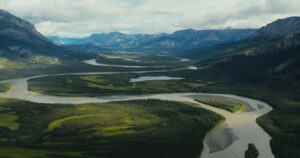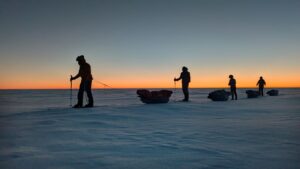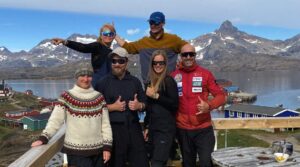Arctic veterans John Dunn and Graeme Magor will soon undertake what is arguably the most interesting northern expedition of the 2022 season — a two-month, spring-summer ski traverse of Axel Heiberg Island. Discovered in 1899 by Norwegian Otto Sverdrup, Axel Heiberg is the world’s third-largest uninhabited island.
Dunn and Magor are two of the Canadian Arctic’s most experienced travelers. They have led multiple sled hauling expeditions in the far north since the late 1980s. Now, even as self-confessed pensioners, the duo are still challenging themselves in the High Arctic. This time, it’s a 950km traverse of the world’s largest island wholly above 78˚N.
Dunn and Magor will fly in by charter (a cool $22,000) to their starting point at the southern tip of Axel Heiberg on April 29. They previously had plans to cross the Canada-Greenland ice bridge in 2020, before the pandemic hit. This year, they switched their sights to Axel Heiberg — a seemingly wise choice, as the ice bridge has not formed sufficiently this year.
The veteran travelers’ route heads north over the Steacie and Strand icecaps to the east coast. Here, they will lay a cache of food for the return leg. Heading back inland and skirting around the Muller Icecap, they plan to reach the turnaround point on the northern tip of the island by June 5, after an estimated 475km of travel.

The red line denotes the outward journey, green line the return route. Photo: John Dunn
Their route is designed for variety, as well as to allow them to put in a cache roughly halfway up the island. The route also has a good chance of reasonable snow conditions throughout May and early June, according to Dunn, which is important for smooth sled travel. By doing an out-and-back loop, Dunn and Magor will save a lot of money on charter flights. It also gives them the option to shorten the route if they find the double traverse is beyond their capabilities.
The return leg sticks to the sea ice of the east coast of Axel Heiberg, which has solid ice for travel, even in June. Dunn and Magor plan to head back inland near Buchanan Lake on the east-central coast.
No one has gone completely around the island since 1932, but “circumnavigation on the [sea ice] would be very dull in my view…not into that!” Dunn says. Hence, the up-and-down route instead. The trend inland will also avoid Eureka Sound, where a significant population of polar bears has bedeviled some previous travelers. This is an especially wise move, given that they not bringing a firearm, to save weight.
Weight is, of course, the obsession of any arctic sledder, and the grizzled veterans hope to keep their sled weight to around 90kgs, including 60 days of food. One area where they will cut weight is stove fuel. By running their stove at one-quarter output, and using a good windscreen and heat exchanger, they plan to carry only 12 litres of white gas for 60 days. In addition, Dunn carries a large black envelope of fabric with a clear cover to trap heat and melt snow. He says that it works down to about -15˚C.
Visiting the fossil forest

Fossil stumps, Axel Heiberg Island. Photo: Jerry Kobalenko
As well as enjoying the High Arctic landscape, Dunn and Magor will take in the sights of this uninhabited wilderness. Around halfway along the outward leg, they will make a short detour to visit the fossil forest, a 50-million-year-old forest of preserved real wood, which was discovered in 1985. Few people have ever visited this natural wonder.
At the northern tip of the island, the experienced pair can take in some arctic history at the Peary cairn. The infamous American explorer Robert Peary built it in 1906 after one of his unsuccessful forays toward the North Pole.

Robert Peary’s wind-blasted 1906 cairn atop Cape Thomas Hubbard at the northern tip of Axel Heiberg Island, overlooking the partly open Arctic Ocean. Photo: Jerry Kobalenko
Dunn predicts that the first 20 days will be the hardest. They will have to travel over two icecaps when the sleds are at their heaviest, and the snow at its coldest. They initially plan to travel by day, before switching over to night travel, thanks to the benefit of 24 hours of daylight.
The return journey in early summer might be troublesome for inland sledding, with windblown areas of rock and sand. They expect to face a 55km portage. They have no specialized equipment (e.g. sled wheels) for this, and simply plan to allow sufficient time for the extra effort. Other options might include sled lining — dragging the sleds along a river from the shore, similar to canoe lining. Or they may also seek higher ground to find remnants of snow.
All being well, Dunn and Magor will finish back at Sherwood Head, the southern tip of the island, on June 30, around two months after setting out.

Magor and Dunn during a crossing of Iceland in 2009. Photo: John Dunn





